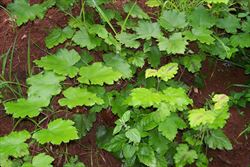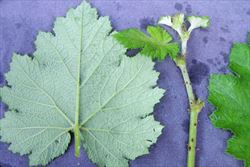Click on images to enlarge

infestation (Photo: Land Protection, QDNRW)

habit with fruit (Photo: Land Protection, QDNRW)

habit with young growth (Photo: Paul Davis)

leaves (Photo: Chris Gardiner)

leaves and flower buds (Photo: Chris Gardiner)

close-up of stem and leaf (Photo: Chris Gardiner)

stem and leaves (Photo: Paul Davis)

stem, leaf stalks and stipules (Photo: Paul Davis)

close-up of young stem and leaf underside (Photo: Paul Davis)
Scientific Name
Rubus alceifolius Poir.
Synonyms
Rubus alceaefolius Poir.Rubus moluccanus L. var. alceifolius (Poir.) Kuntze
Family
Rosaceae
Common Names
Asian bramble, bramble, giant bramble, wild raspberry
Origin
Native to south-eastern Asia (i.e. China, Taiwan, Cambodia, Laos, Myanmar, Thailand, Vietnam and western Indonesia).
Naturalised Distribution
This species is naturalised in the coastal districts of northern and central Queensland. It is mostly found in the wet tropics of north-eastern Queensland, between Tully and Cairns (including the wetter eastern parts of the Atherton Tableland), and is especially common around Babinda and Gordonvale. There is also one record from the Port Curtis pastoral district in central Queensland.
Also naturalised on La Réunion in the Indian Ocean.
Habitat
This species readily invades pastures, roadsides, and other cleared areas in the wet tropics of Queensland. It also inhabits wet gullies, creekbanks, sugarcane plantations, the edges of rainforests and logging tracks.
Habit
A vigorous, scrambling, long-lived (i.e. perennial) shrub developing a woody rootstock. It is capable of covering other plants and forming dense thickets.
Distinguishing Features
- a vigorous, scrambling, long-lived shrub forming dense thickets.
- its arching stems become thick canes (up to 5 m long) and are covered with brown hairs and hooked prickles.
- its large alternately arranged leaves are green above and velvety brown below.
- these leaves have 5-7 shallow and finely toothed lobes.
- its white flowers are borne in small clusters at the ends of shorter secondary branches.
- its fruit is a fleshy 'berry' that turns red when mature.
Stems and Leaves
The stems are upright (i.e. erect) at first and then later arch and become thick canes (up to 5 m long). They scramble over other plants, taking root where they touch the ground and producing daughter plants (i.e. by layering). The younger stems are covered with felty brown hairs and have some small hooked prickles (up to 4 mm long).
The simple leaves are large (8.5-20 cm long and 7-20 cm wide) and alternately arranged along the stems. They are borne on stalks (i.e. petioles) 35-55 mm long that are also somewhat hairy (i.e. pubescent) and prickly. The leaf blades have 5-7 shallow lobes that are finely toothed (i.e. serrated) at the margins. The upper leaf surface is green and somewhat hairy (i.e. pubescent), while the undersides are densely hairy (i.e. they are velvety pubescent) and usually brownish or yellowish in colour.
Flowers and Fruit
The white flowers (15-20 mm across) are usually borne in small clusters (of up to 10 flowers) at the ends of short secondary branches (about 10 cm long). These secondary branches are produced in the forks (i.e. axils) of the leaves along the main stems. Each flower is borne on a stalk (i.e. pedicel) 5-14 mm long and has five sepals (9-10 mm long and 5.5-7 mm wide). These sepals are densely covered with whitish hairs (i.e. pubescent) on both surfaces and become enlarged and bent backwards (i.e. reflexed) in fruit. The flowers also have five rounded petals (7-9 mm long and 7-8.5 mm wide) and numerous stamens. Flowering can occur throughout the year, but is probably most abundant during summer and autumn.
The fruit is a fleshy (i.e. succulent), rounded (i.e. globular), 'berry' (actually an aggregate fruit) that turns red when mature. These fruit (16-25 mm across) are made up of numerous small segments (i.e. drupelets), each containing a small seed. The seeds (about 2.5 mm across) are black in colour and either somewhat rounded (i.e. sub-globular) or kidney-shaped (i.e. reniform). Fruit are present mainly during late autumn and winter (i.e from May to August).
Reproduction and Dispersal
This species reproduces by seed and also vegetatively by rooting of stems tips (i.e. a process called layering).
Birds and other animals spread the seeds after ingesting the fruit and clumps may spread outwards via layering. Seeds and stem pieces may also be dispersed in floodwaters, or when they are incorrectly disposed of.
Environmental Impact
Giant bramble (Rubus alceifolius ) is regarded as an environmental weed in Queensland. This species forms dense, impenetrable, thickets of vegetation in wet gullies, along creekbanks and in rainforests margins in the humid tropical regions of this state.
Other Impacts
Giant bramble (Rubus alceifolius ) invades pastures, particularly on newly cleared land, where it reduces pasture productivity and access to water.
Legislation
Not declared or considered noxious by any state government authorities.
Management
For information on the management of this species see the following resources:
- the Biosecurity Queensland Fact Sheet on this species, which is available online at http://www.dpi.qld.gov.au.
Similar Species
Giant bramble (Rubus alceifolius) is often confused with Molucca bramble (Rubus moluccanus), which is sometimes also known as "wild raspberry". These two species can be distinguished by the following differences:
- giant bramble (Rubus alceifolius ) has relatively large leaves (8.5-20 cm long) with 5-7 shallow lobes. There are a pair of relatively large (about 15 mm long and 15 mm wide) leafy structures (i.e. stipules) on the stem near the base of each leaf stalk (i.e. petiole). The flowers are white and the fruit are made up of numerous segments (i.e. 110-180 carpels).
- Molucca bramble (Rubus moluccanus) has relatively small leaves (4.5-15 cm long) that are unlobed or three-lobed. There are a pair of relatively small (about 12 mm long and 6 mm wide) leafy structures (i.e. stipules) on the stem near the base of each leaf stalk (i.e. petiole). The flowers may be white or pink and the fruit are made up of relatively few segments (i.e. 35-70 carpels).
It is also similar to several other native and introduced brambles (i.e. Rubus spp.), but the other species present in Queensland generally have compound leaves (i.e. their leaves divided into three or more leaflets). For a more in depth guide to distinguishing between all of the brambles (i.e. Rubus spp.) present in Australia see Blackberry: an identification tool to introduced and native Rubus in Australia.

